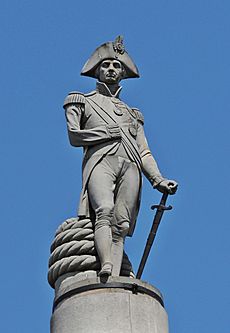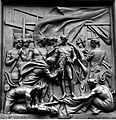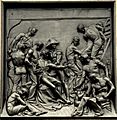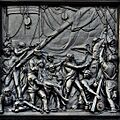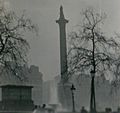Nelson's Column facts for kids
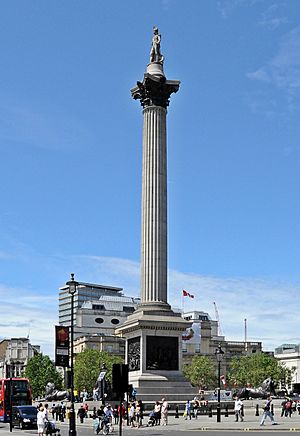
Nelson's Column, Trafalgar Square
|
|
| Coordinates | 51°30′27.8″N 0°07′40.7″W / 51.507722°N 0.127972°W |
|---|---|
| Location | London, WC2 United Kingdom |
| Designer | William Railton, Edward Hodges Baily and Sir Edwin Landseer Also: Musgrave Watson, William F. Woodington, John Ternouth and John Edward Carew (sculptors), Grissell and Peto (contractors) |
| Type | Victory column |
| Material | Granite and bronze |
| Height | 169 feet 3 inches (51.59 m) |
| Beginning date | 1840 |
| Completion date | 1843 |
| Opening date | 1843 |
| Dedicated to | Admiral Horatio Nelson |
Nelson's Column is a very famous monument in Trafalgar Square, located in the middle of Central London. It was built to remember Vice-Admiral Horatio Nelson, a British naval hero. He won a huge sea battle called the Battle of Trafalgar against the French and Spanish navies. Sadly, he died during this important battle.
The monument was built between 1840 and 1843. It was designed by an architect named William Railton. Building it cost about £47,000 back then, which was a lot of money! The tall column is made of strong Dartmoor granite. It is built in a style called Corinthian.
On top of the column is a statue of Nelson himself. It was carved from Craigleith sandstone by the sculptor Edward Hodges Baily. Around the bottom of the column, you will see four big bronze lions. These were designed by Sir Edwin Landseer and added later, in 1867.
The base of the column, called the pedestal, has four large bronze pictures. These are called relief panels. Each one is about 18 feet (or 5.5 meters) square! These panels were made from melted-down French cannons. These cannons were captured in battles. They show scenes from Nelson's famous battles: the Battle of Cape St. Vincent, the Battle of the Nile, the Battle of Copenhagen, and Nelson's death at Trafalgar. Different sculptors created these detailed scenes. The fancy top part of the column, just under Nelson's statue, was designed by Charles Harriott Smith.
In 2006, the column was cleaned and repaired. This cost about £420,000. During this work, they measured it carefully. They found out it was a bit shorter than people had thought! The whole monument, from the bottom of the base to the top of Nelson's hat, is 169 feet 3 inches (51.59 m) tall. The statue of Nelson alone is 17 feet (5.2 m) high.
Contents
How Nelson's Column Was Built
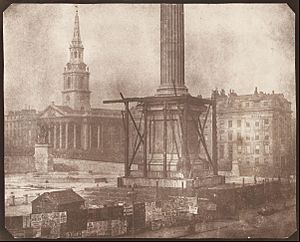
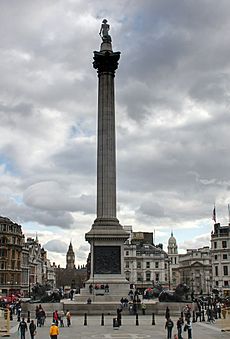
Planning the Monument
In February 1838, a group of important people decided to build a monument for Lord Nelson. This group included Members of Parliament (MPs). They wanted to pay for it by asking the public for money. This is called public subscription. The government agreed to give them a spot in Trafalgar Square. This spot was right in front of the National Gallery, which had just been finished.
To choose the best design, they held a competition. They thought it would cost between £20,000 and £30,000. Artists and architects had to send in their ideas by January 31, 1839.
The winning idea came from William Railton. He designed a tall Corinthian column. It would have a statue of Nelson on top and four big lion statues at the bottom. There would also be steps leading up to the base of the column. Another artist, Edward Hodges Baily, won second prize. His idea was for an obelisk, which is a tall, four-sided pillar, with sculptures around it.
Some people were not happy with how the first competition was run. So, they did it again. Mr. Railton sent in a slightly changed design and won a second time! This time, they decided that Mr. Baily should make the statue of Nelson.
Originally, the column was going to be 203 feet (62 m) tall. But people worried it might not be stable. So, they made it shorter, 170 feet (52 m) tall. At first, they planned to use granite for the base and sandstone for the main part of the column. But before they started building, they decided to make the main part out of granite too. This was to make it stronger.
Building the Column
They started digging for the foundations in July 1840. On September 30, 1840, the very first stone of the column was laid. It was a quiet ceremony. Many of the important people on the committee were out of town. The company Grissell and Peto built the monument. It took a while. The stone part of the column was not ready for Nelson's statue until November 1843.
By 1844, the committee that was raising money for Nelson ran out of funds. They had only collected about £20,485 from the public. So, the government had to step in and take over the project.
Adding the Bronze Panels and Statue
It took even longer to add the bronze pictures (reliefs) to the base of the column. The first one, showing Nelson's death, was put up in late 1849. The next year, the panel showing the Battle of the Nile was added.
There was a problem with the panel for "The Battle of Cape St. Vincent." The company making it had mixed iron into the bronze. This was to save money. The people in charge had to fix this. Another company had to finish the panel. It was finally put in place in May 1854.
The 17 feet (5.2 m) tall statue of Nelson on top was made by Edward Hodges Baily. He carved it from three big pieces of Craigleith sandstone. This special stone was given by the Duke of Buccleuch. He used to be in charge of the Nelson Memorial Committee. The stone came from his own quarry in Scotland.
Nelson's statue stands on the tall column made of granite blocks from Dartmoor. The fancy top part of the column (the capital) is made of bronze. This bronze actually came from cannons. These cannons were saved from an old ship called HMS Royal George. It was designed to look like a part of the Temple of Mars Ultor in Rome. Some of these bronze pieces are very heavy. They weigh as much as 900 pounds (410 kg)! They are attached to the column with strong metal bands.
A Target for Hitler?
The column was also important to Adolf Hitler, the leader of Germany during World War II. If his plan to invade Britain, called Operation Sea Lion, had worked, he wanted to take Nelson's Column apart. Then he wanted to move it to Berlin. Luckily, his plan failed!
The Famous Lions of Trafalgar Square
The four huge bronze lions at the bottom of Nelson's Column were not added until 1867. This was quite a while after the column itself was finished.
Finding the Right Lions
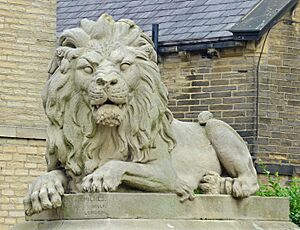
At first, they thought about making the lions out of granite. A sculptor named John Graham Lough was chosen for the job. But in 1846, he decided not to do it. He did not agree with the architect's rules.
Later, in 1858, another sculptor, Thomas Milnes, got the job. He made four big models of lions out of sandstone. Each one was meant to show something different: Peace, War, Vigilance (being watchful), and Determination. But these designs were turned down.
So, the job went to Sir Edwin Landseer. He was a very famous painter. Even Queen Victoria liked his work. The sandstone lions that Milnes made were bought by a factory owner named Sir Titus Salt. He put them in his workers' village, Saltaire, in 1869. You can still see them there today.
Landseer's Lions
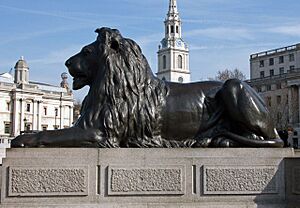
The bronze lions we see today were designed by Sir Edwin Landseer. He had help from another artist, Carlo Marochetti. Some people think Landseer might have been inspired by lion statues on a bridge in Budapest, Hungary. This bridge is called the Széchenyi Chain Bridge.
To make his lions look real, Landseer asked for plaster casts (moulds) of a real lion from Turin, Italy. But they did not arrive until 1860. While he waited, he drew pictures of lions at the London Zoo. Eventually, he was given the body of a dead lion to study. It took a long time to finish the sculptures. Because of this, the lion's body started to decay. This might be why some parts of the statues are not perfectly like a real lion. For example, their paws look more like a cat's paws. Their backs curve inwards instead of outwards.
The four bronze lions were finally put in place in 1867. Landseer was paid £6,000 for his work. Marochetti received £11,000.
In 2011, experts said that tourists climbing on the lions were causing a lot of damage. They suggested that people should not be allowed to climb on them anymore. This is to protect these famous statues.
Keeping the Column Clean and Strong
Over the years, Nelson's Column has needed cleaning and repairs. This helps keep it looking its best.
In 1968, the column was cleaned using a method called sandblasting.
More recently, in 2006, it had a major refurbishment. Scaffolding, which is a temporary metal frame, was put up all around the column. This allowed workers to reach every part of it. They used steam cleaning and gentle rubbing materials. This cleaned the stone and bronze without damaging them. This big cleaning job cost £420,000. A company called Zurich Financial Services paid for it. They were allowed to put advertisements on the scaffolding while the work was being done.
Before they started the 2006 cleaning, workers used lasers to measure the column very carefully. They discovered that it was actually a bit shorter than people had always thought. Instead of being 185 ft (56.4 m) tall, it measures 169 ft (51.5 m) from the bottom step to the very top of Admiral Nelson's hat.
Climbing the Column: Stunts and Statements
Nelson's Column is so tall and famous that some people have climbed it. They have done this for fun, for TV shows, or to get attention for important causes.
For Fun and TV
- In 1977, John Noakes from the BBC children's TV show Blue Peter famously climbed the column.
- In 1989, TV presenter Gary Wilmot also climbed it for a TV show. He dressed up in old-fashioned clothes. These were like what people wore in 1843 when the column was finished. He even had tea and sandwiches at the top before climbing down!
Drawing Attention to Causes
Sometimes people climb the column to make a statement about something they believe in.
- The first person to do this was Ed Drummond in 1978. He climbed it to support the Anti-Apartheid Movement. This movement was against unfair treatment of people in South Africa. He used the lightning conductor to help him climb.
- People from the environmental group Greenpeace have climbed it several times. For example, in 1988, they climbed it to raise awareness about acid rain. In 1992, they climbed it to protest about environmental issues. This was during an important meeting called the Earth Summit.
- In 1995, a famous climber named Simon Nadin climbed it without ropes (free-climbed). This was to bring attention to the problems faced by the Inuit people of Canada.
- In May 2003, a BASE jumper and stuntman named Gary Connery parachuted off the top of the column. He did this to draw attention to issues in Tibet.
- In April 2016, Greenpeace activists climbed the column very early in the morning. They put a breathing mask on the statue of Admiral Nelson. This was to protest against air pollution.
Special Promotions
- In December 2015, Disney paid £24,000 to decorate the column with lights. They made it look like a giant lightsaber from the Star Wars movies. This was to promote the film Star Wars: The Force Awakens.
It is important to remember that climbing the column without permission is dangerous and not allowed.
Other Tributes to Admiral Nelson
The famous column in London is not the only monument built to remember Admiral Nelson. Many other places also wanted to honor this naval hero.
Monuments in the UK
- The very first big monument for Nelson was actually built in Glasgow, Scotland, in 1806. It is a tall, pointed stone pillar called an obelisk.
- Scotland has other Nelson monuments too. These include Nelson's Tower in Forres and the Nelson Monument on Calton Hill in Edinburgh.
- In Birmingham, England, there is a bronze statue of Nelson made in 1809.
- Portsmouth, where Nelson's famous ship HMS Victory is, has Nelson's Needle on a nearby hill. The crew of the Victory paid for this one.
- Great Yarmouth in England also has a tall column called the Britannia Monument, built in 1819.
Monuments Around the World
- In Montreal, Canada, people built Nelson's Column in 1809. Just like the one in London, the statue of Nelson in Montreal has his back to the sea.
- There is even a Mount Nelson near Invermere in Canada.
- Bridgetown, the capital of Barbados, has a statue of Lord Nelson in its own Trafalgar Square. This statue is actually older than the one in London!
These are just a few examples. Many places wanted to remember Admiral Nelson and his important victories.
Gallery
-
The Battle of Cape St. Vincent by Musgrave Watson and William F. Woodington, the relief on the west face of the plinth
-
The Battle of the Nile by William F. Woodington, the relief on the north face of the plinth
-
The Battle of Copenhagen by John Ternouth, the relief on the east face of the plinth
-
The Death of Nelson at Trafalgar by John Edward Carew, the relief on the south face of the plinth
-
The column during the Great Smog of 1952
See also
 In Spanish: Columna de Nelson para niños
In Spanish: Columna de Nelson para niños
- Berlin Victory Column
- Congress Column
- July Column


